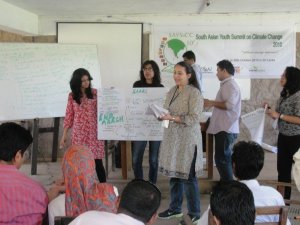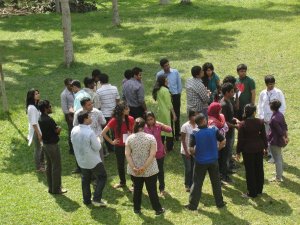It was different experience in Colombo this past week, as twenty youth traveled all the way to meet, enthuse, engage and empower each other. We all had gathered because we have one common belief- that we will tackle the impacts of climate change together. The South Asian Youth Climate Action Network (SAYCAN) consisted of youth participants from India, Bangladesh, Pakistan, Nepal, Maldives, Afghanistan, and Sri Lanka- countries that are most vulnerable to the impacts of Climate Change.
All these youth were different in there own ways with extremely diverse backgrounds. Some studied Environmental Management, some, Economics, some Computer Engineering, some Journalism and Mass Communication and some Literature or Law. They speak different languages, different dialects, in different ways. Some are passionate about science, and others about art.
They have different tastes too, mind you. Some like shopping till they drop, and some like sight seeing. Some are into books and philosophy, some into music and some into photography. They look at life differently and live differently. Some believe in the peace of finding calm and quite within themselves to lead life. some find solace in finding little things in life beautiful and making the best out of it.
They all work on projects and programs, relating to environment and climate change. Their designs are different, so are their models. They have lots of ideas, and energy.
How do you bring them under the same roof, how do you get them to agree on the same goal, vision, and action plan for the South Asian youth?
This was the challenge for SAYCAN- to bring all these youth to explore and agree on common goals and aspirations and make them draw the road map for the network. There is a always a fear for these attempts to turn into talk shops, to deviate into something completely different.

Lets face it. Climate Change movements have been extremely challenging. Following last year’s BIG failure at COP 15, challenges seem to take a greater toll.
Many articles continue to suggest different pictures of this big game- some say it is time to give up, the political order of liberal democracy is just incapable of rising to this challenge. Others, continue to believe that the world’s biggest polluters will not bend and the rest bring in new models to combat climate change. Stephen Hawking being the man of physics, suggests that mankind should colonise distant planets. James Lovelock thinks the remnants of humanity will seek refuge on the tropical shores of the Arctic.
Moving to the scientists, some suggest climate change does not exist to begin with and other scientific data now strongly suggests that physical and biological changes in the planet are increasingly greater than those defined by the modelling in the most recent Intergovernmental Panel on Climate Change (IPCC) report. Despite the steadily rising levels of carbon dioxide in the atmosphere, even countries expressing commitment are having little impact compared to the huge task in hand.
Governments continue to fight, focusing on the monetary values than trying to just solve the issue first. Everything is being calculated. Survival of people is being negotiated. It is all about the money. It is all about mandates. It is all about negotiation.
In the middle of this, you have youth movements striving everyday to fight for this cause. You can tell, that some of these passionate people would one day give up and just walk away, instead of watching the whole climate debate go no where. After all, isn’t that the only way to not hurt?

I myself, could not help, but wonder what it was that had brought some 20 of us together to fight for a cause that is under so much criticism and how we would agree on anything by the end of it all. More often than not, all around us, passion seems to seep away and leave behind just uncertainties and insecurities. This cause has the same potential.
Then, why, despite all questions, have all these youth come together for this conference? Why spend so many hours, all day long brainstorming, planning and designing action plans to tackle climate change in our own little ways? Our governments do not recognize our strength and we are never a part of the policies that run our lives. Then why bother?
Some of these people have stayed up nights to make this possible, run around from one funding organization to the other, in hope of organizing a conference for youth. Some have skipped their biggest events, some have paid out of their own savings, just to be here. together.
It was during the first night at the beach that I stared at the distant endless ocean, waves slapping against the hot sand of the beach, while I felt my feet burrowing into the deeper depths of the cool sand. I wondered, why I was here? Why all these people were here? why so many of these youth were working so hard in their own country for this cause?
I could not help but think of this Greek myth.
Greek myths never failed to fascinate me. Somehow, I seem to have had the greatest fascination of all towards the Greek mythology since God knows when. Staring at the beach, the story of Pandora’s Box came to my mind so many times.
According to Greek myth, Pandora was the first woman on earth created by the Greek Gods. She was stunning and she was created by Zeus to take revenge on mankind. It is said that the Gods would give her gifts. Each one of them. Which is why her name meant ‘the bearer of gifts’. Pandora was given a beautiful box by the Gods and asked never to open it. Pandora, however, could not resist herself and had finally opened the box, which let out all the misdeeds, diseases, hatred, greed, jealousy, pain and sufferings in the world.
Pandora shocked and guilty, had closed the box as soon as possible to ensure nothing else came out of that box to destroy the world. Zeus wanted Pandora to open this box, so she could bring sufferings into this world. It is said that this story explains the world we live in today- the world where we are consumed by jealousy, anger, selfishness, hatred, greed and many more.
However, the myth also suggests, the box was closed and there was still something left there, and that was Hope.
Greek myths never explained further as to why hope was left in the box- if hope should be taken in absolute sense or narrow sense. There have been millions of interpretations of this myth since then. Archaic and classic Greek literature went further to explain the concept of hope. One thing that came out of the mythographers was that hope was not gone. Hope was inside that box, intact, to ensure that mankind has the ability to live through all the odds that life has stored for us.
True or not, personally, I have believed this version of the story- that hope is intact and will keep us going come what may. I would have died, had I not seen a glimpse of hope in my life. In the worst times of my life, hope pulled me through. Every morning that I wake up, I wake up with hope, as though it is a part of me, a part of who I am and the sheer reason for my survival.
And I realised, it is hope, too, that brought all these South Asian Youth Together, to ‘enthuse, engage and empower’ in the middle of all the stories of Climate Change and failure.
For us youth, science or economics is not the basis for negotiation of our survival. True, there may be big failures, and true, there may not be any end to this long debate and our efforts may never be recognized. True, negotiations may never come to an agreement.
But, it is hope that keeps us going. Everywhere. Everyday. And we continue to work, together, in our little ways with that one thing that keeps us together- and that is hope. for better days to come.



